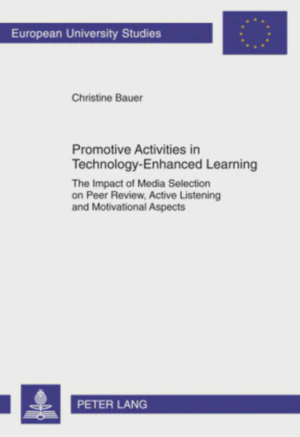Promotive activities in technology-enhanced learning: the impact of media selection on peer review, active listening and motivational aspects

Abstract
Numerous studies indicate that learning is most effective in terms of persistency when it addresses the whole person rather than merely the intellect. Based on the person-centred approach to learning, a set of non- directive, promotive activities that foster significant learning have been identified and extensively researched in classroom settings. Equally, it turned out that technology-enhanced learning settings, which thoughtfully combine online elements with learning in presence phases, have benefits compared to pure e-learning or traditional learning settings in class. For instance, a combination allows creating or making use of distinct settings according to requirements of, for example, different learning phases, activities, or styles, etc. that are most likely distinct as also the results of this work show. Adopting the well-proven promotive activities to technology-enhanced learning environments is, though, challenging as transferring these activities to technology-enhanced settings requires appropriate media selection, adequate adaptation of activity patterns to a chosen setting, and – above all – respective media competence that allows for conveying the underlying interpersonal qualities with the respective medium. Nevertheless, as this work demonstrates, the person-centred approach with the three levels of learning and personal growth (intellect, social skills, and personality) and technology-enhanced learning complement one another and are, thus, a particularly effective combination. The major scientific goal of this work is to investigate whether and how non-directive, promotive activities may be applied in cooperative technology-enhanced learning settings. Besides transferring existing activity patterns to the online context, this work presents – by giving practical examples – new opportunities that could only emerge with technology enhancement. With respect to promotive activities, the main three fields of interest are: motivational aspects, the impact of media selection on peer review, and active listening with means of written online communication. By combining qualitative and quantitative methods, these aspects have been investigated in a scale of studies conducted in five distinct courses at the University of Vienna. Four distinct courses, which implement similar but, though, different course designs, were compared with the aim to identify pedagogical elements that drive motivation. As expected, students appreciate the person-centred style. Furthermore, rewarding self-initiative and high practical relevance are qualified motivation drivers. Investigating the impact of media selection, two case studies compared online and face-to-face peer reviews. With respect to cooperative learn- ing, the studies explored communication and collaboration aspects. Furthermore the quality and kind of feedback were analysed. Essentially, the setting with written online peer review and the possibility to raise a query seemed highly appropriate. Adopting the highly recognised face-to-face communication concept of active listening in settings with written online communication is a novel asset that had been explored in two case studies. Demanding both verbal and nonverbal skills, this way of communication improves mutual understanding by using techniques like paraphrasing. For instance, it avoids misunderstandings and in conflicts people tend to be more willing to explain in detail, which increases chances to find a joint solution. The presented studies investigate active listening in an educational setting using written online communication. Thereby, the focus laid on instant messaging and e-mail communication, examining both settings’ capacities and differences and exploring whether active listening is effective in written online communication. Besides demonstrating that active listen- ing is not limited to an oral setting, these studies aimed at investigating students’ media competence. Interestingly enough, students’ report scepticism although analysis of their communicative behaviour provides evidence that students are able to overcome the difficulties of the respectively used media (instant messaging and e-mail) and can, hence, apply the concept accordingly. While, naturally, there are limitations to expressing empathy in online settings, the latter were found to offer valuable opportunities that face-to-face conversations tend to lack. For instance, it appears that instant messaging tools leave control with the person who expresses his or her thought. This allows this person to completely verbalise his or her thought before responding. Analysis re- veals that the benefits can already be observed with newcomers to the concept. Finally, the work draws up general recommendations concerning promotive activities in technology-enhanced learning settings in higher education targeted at students of business informatics and computer science. Findings do not only give direction to educators but do, more- over, provide indication for tool designers, what they need to take into consideration when developing tools that support whole person learning.